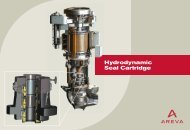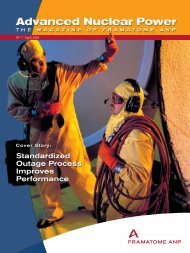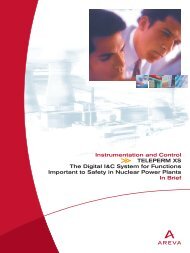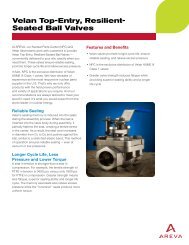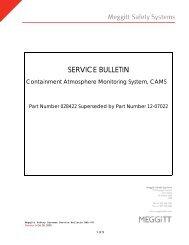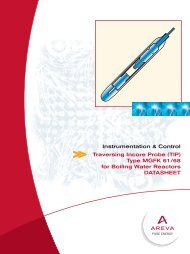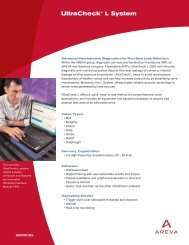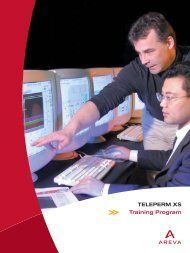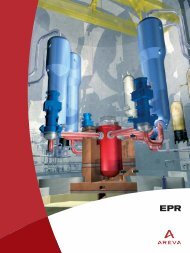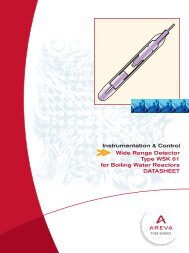Download - AREVA
Download - AREVA
Download - AREVA
- No tags were found...
You also want an ePaper? Increase the reach of your titles
YUMPU automatically turns print PDFs into web optimized ePapers that Google loves.
“I believe that every nation involvedin Gen IV recognizes the benefits ofworking together, leveraging resources,and creating a common roadmap tothe development of this technology,”he said.It is an appropriate example. Both theEU and the United States see nuclearenergy as one means of producinghydrogen.A role fornuclear energyEU experts have suggested that nuclearenergy has a role to play in boththe medium and long term. Betweennow and 2020, nuclear power plantscould provide electricity for waterelectrolysis – a current method ofproducing hydrogen. Indeed, today’sreactors could produce hydrogenby this means. Beyond 2020, the heatfrom a high-temperature gas-cooledreactor could be used for thethermochemical decomposition ofwater – a more efficient means ofhydrogen production.The International Energy Agency(IEA), too, identifies nuclear energy asone of the non-emitting sources ofelectricity that can be used to producehydrogen. The IEA’s standing groupon long-term cooperation says thehigh-temperature gas-cooled reactor isone area for research, developmentand deployment in the mediumto long term.DOE’s National Hydrogen EnergyRoadmap, issued in November 2002,calls for the development of “advancednuclear energy methods” to producehydrogen, which “would avoid carbonemissions.” Thermochemical watersplitting using high-temperatureheat from advanced reactors could beUS Energy Secretary Spencer Abraham and CommissionerPhilippe Busquin of the EU followed up the earlier agreementwith the signing of an agreement on June 16, 2003 for thedevelopment of fuel cells.included in future nuclear plantdesigns, notes the roadmap.The DOE’s recently released energystrategy also includes the advancementof nuclear energy – among othertechnologies – to produce hydrogen.The strategy notes that the agency iscommitted to the development ofadvanced nuclear energy technologies.And in its technology roadmap forGeneration IV nuclear energy systems –prepared by experts from numerouscountries – DOE states that one of itssustainability goals is “having a positiveimpact on the environment throughthe displacement of polluting energyand transportation by nuclear electricitygeneration and nuclear-producedhydrogen.” In the agency’s vision,nuclear energy would become the vitallink in the energy supply chain.A ministerial-level conference scheduledfor November 2003 in Washington, D.C.,is expected to culminate in theestablishment of the InternationalPartnership for the Hydrogen Economy.At the meeting, energy ministers candiscuss common areas of interest inresearch, development and demonstrationprojects, hydrogen policy andregulation, and the commercializationof hydrogen-based energy technologies.At a meeting in Brussels in May,2003 US and EU hydrogen technicalexperts identified potential areasfor cooperation, including codes andstandards, fuel cell technology,hydrogen production and storage.“I believe this is an area where boththe US and the EU would benefitfrom cooperating, notably on ourresearch programs and demonstrationprojects,” Loyola de Palacio said aftermeeting DOE’s Abraham in Brusselsin May. Through collaboration,they may one day bear out Verne’sprediction. ■Advanced Nuclear Power N O 9 November 2003 7



